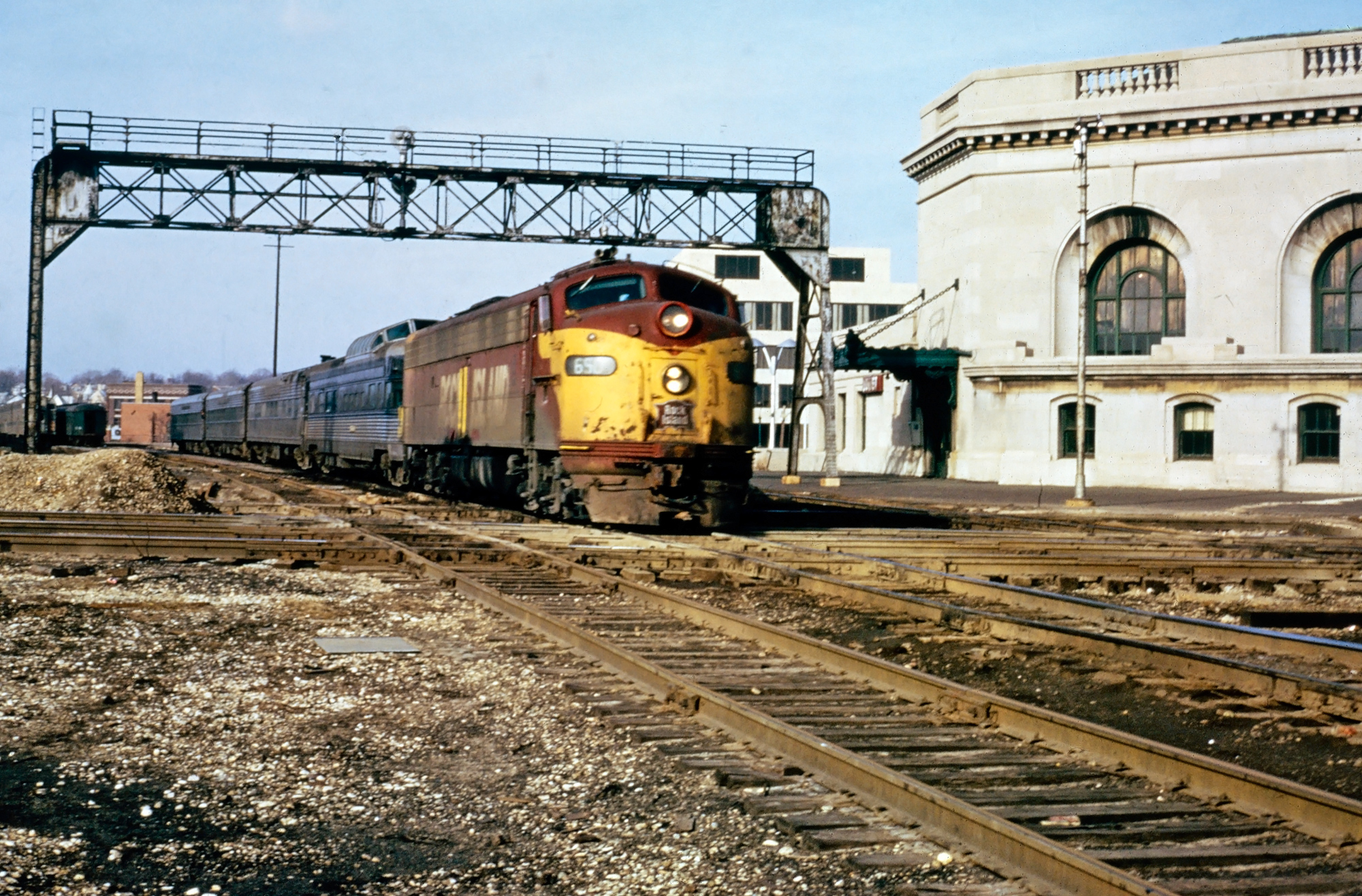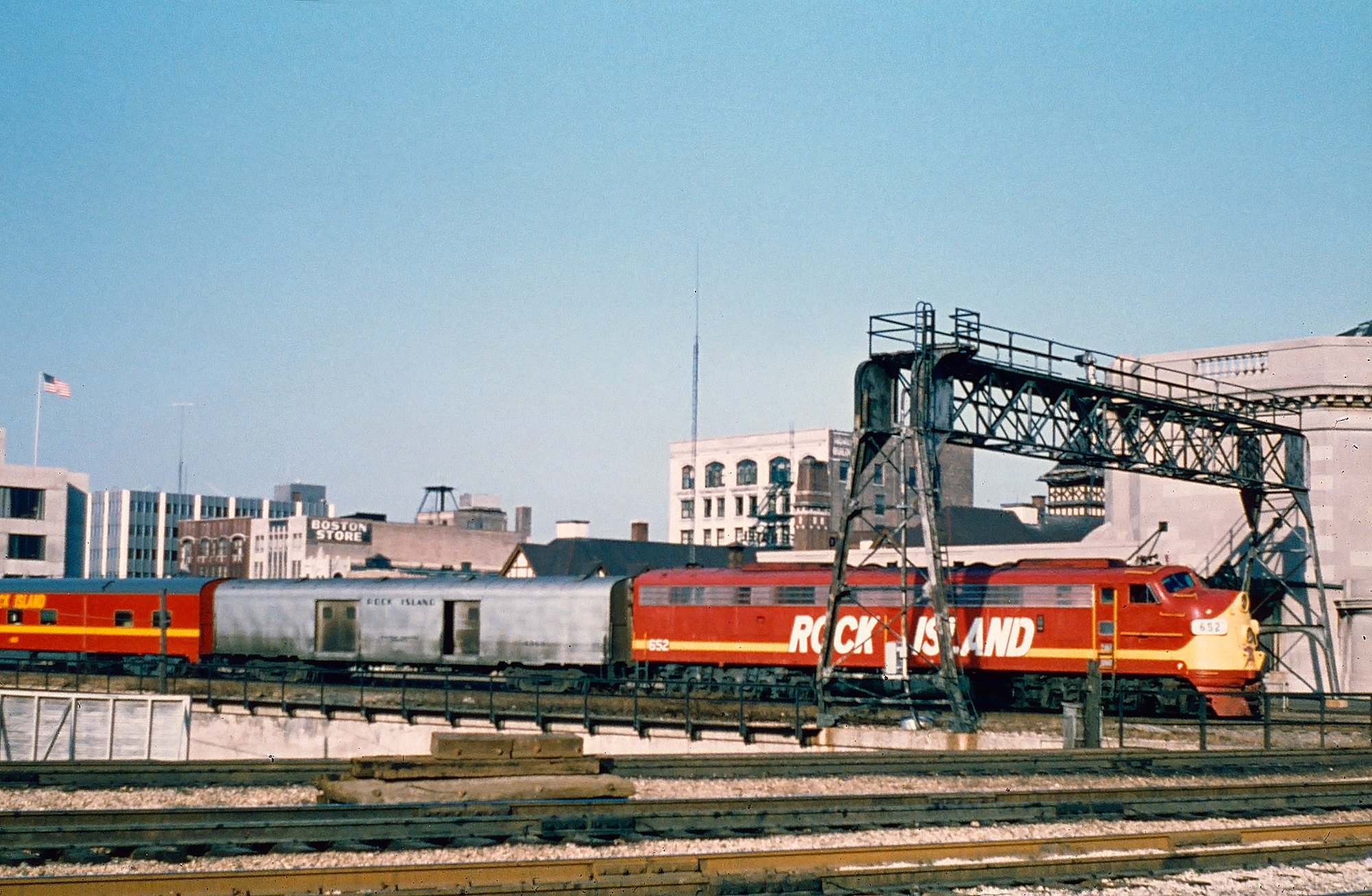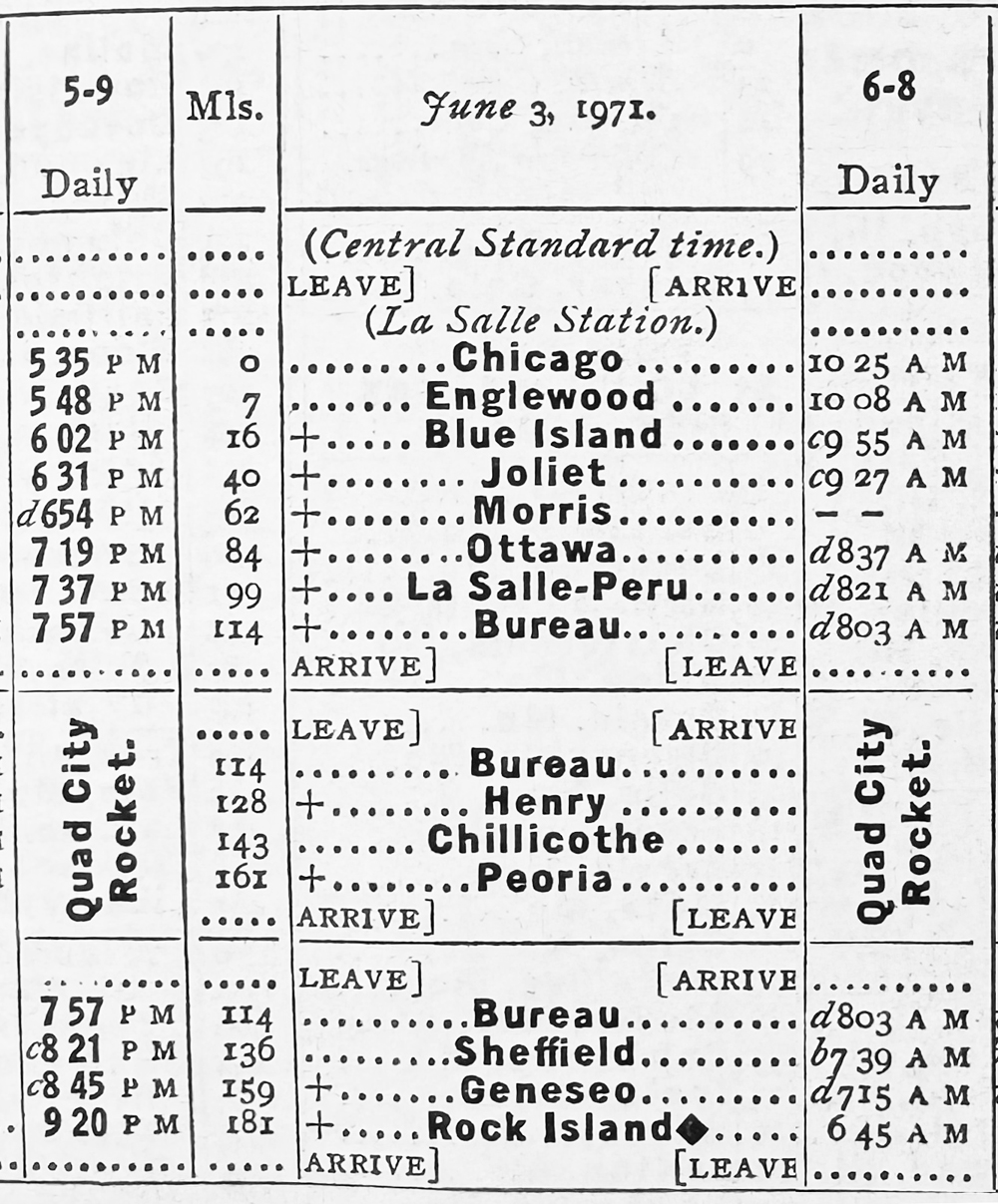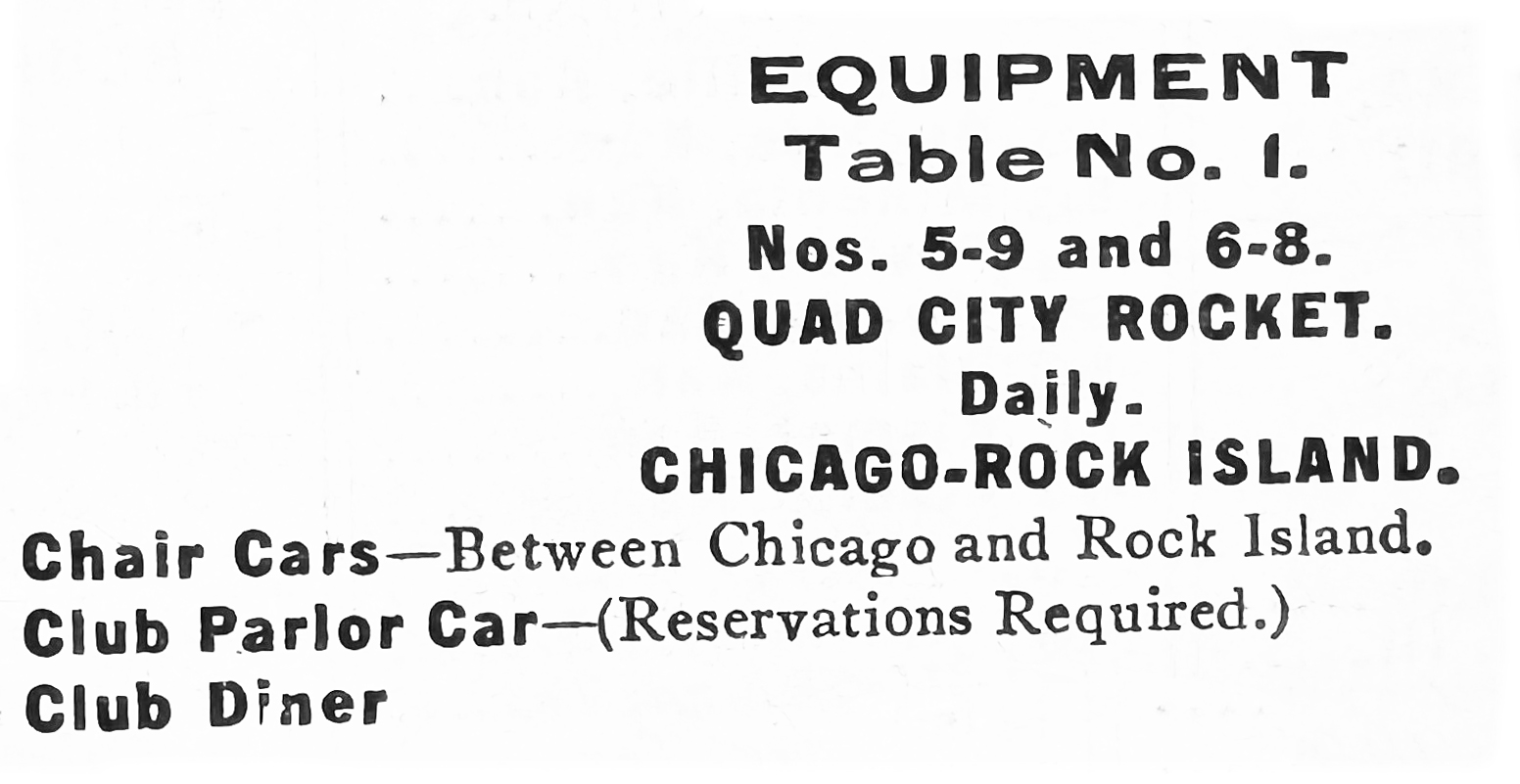"Quad Cities Rocket" (Train): Schedule, Route, Consist
Last revised: March 3, 2025
By: Adam Burns
The Quad Cities Rocket was a late-era service operated by the Chicago, Rock Island and Pacific, charting its course between Chicago and Rock Island, Illinois.
This train was a legacy from one of Rock Island's flagship services, the Rocky Mountain Rocket. Following the curtailment of the Rocky Mountain Rocket's route to Omaha in 1966 and a brief period without a designated name, it emerged as The Cornhusker.
In 1970, the train saw its final transformation, with its western terminus scaled back to Rock Island. Train enthusiats colloquially referred to this service as the Quad Cities Rocket.
The train persisted as one of the two remaining services for the Rock Island Railroad after the advent of Amtrak on May 1, 1971—the Peoria Rocket being the other. In that same year, the route expanded to include a stop at Sheffield.
After battling with the state of Illinois to discontinue the train, the Interstate Commerce Commission ruled in May, 1978 the Rock Island could discontinue the service and the train made its final run on December 31, 1978.
 A very tired Rock Island E8A, #650, has the eastbound "Quad Cities Rocket" at Joliet, Illinois in March, 1974. American-Rails.com collection.
A very tired Rock Island E8A, #650, has the eastbound "Quad Cities Rocket" at Joliet, Illinois in March, 1974. American-Rails.com collection.Historical Context and Inception
In the Golden Age of rail travel, the 1930s through the 1950s, American railroads competed fiercely to attract passengers with faster, more luxurious, and more reliable services.
The Quad Cities Rocket harkens back to the Rock Island's original Rocket streamliner fleet which entered service in 1937.
The Rock Island, officially known as the Chicago, Rock Island, and Pacific Railroad, had a storied history dating back to the mid-19th century and was known for its innovative services and supportive infrastructure in the Midwest.
Design and Features
Heralding an era of streamlined Art Deco design, the original Rockets featured luxurious coaches, dining cars, and observation lounges, exuding an air of sophistication.
The train's streamlined locomotive, often early EMD models, epitomized the cutting-edge technology of the time, favoring both speed and efficiency.
The train's interior aesthetics married functionality with comfort. Plush seating, well-appointed dining services, and panoramic windows enriched the travel experience, allowing passengers to witness the evolving landscapes of the Midwest in style.
The Rocket's coaches were equipped with air conditioning— a hallmark of luxury at the time— making journeys comfortable even during the sweltering summer months.
Schedule and Operations
Serving a distance of approximately 180 miles between Chicago and the Quad Cities, the Quad Cities Rocket was designed for speed and frequency.
From its inception, the train made daily trips, with schedules crafted to accommodate both business and leisure travelers.
Two daily round trips were typically scheduled, ensuring that passengers could make timely returns the same day if needed.
The typical schedule saw departures from Chicago's LaSalle Street Station, a hub bustling with activity, emphasizing the connection between one of the nation's largest cities and the economically vibrant Quad Cities region.
With stops at Joliet, Morris, Ottawa, LaSalle, and Bureau, among others, the Rocket seamlessly connected urban centers and smaller towns, fostering economic and social interplay.
Economic and Social Impact
The Rocket's influence stretched beyond mere transportation. It became a vital economic artery, facilitating commerce and trade. Businesses in the Quad Cities region found easier access to Chicago's vast market, while Chicagoans could travel conveniently for business or pleasure to the region. The Rocket also played a significant role during World War II, moving troops and equipment efficiently between key locations.
Passenger trains like the Quad Cities Rocket were more than transportation modes; they were social spaces where different strata of society mingled. They fostered camaraderie among frequent travelers and became integral in the lives of those who relied on the rail network for daily commutes or business travels.
Timetable (1971)
Consist (1971)
Challenges and Evolution
### Decline of the Quad Cities Rocket
By the 1960s and 1970s, the Rock Island Railroad was in financial decline, grappling with reduced passenger numbers and increasing operational costs. Despite the Railroad Reorganization Act of 1973, which aimed to restructure struggling railroads, the Rock Island line continued to falter.
The advent of the Amtrak system in 1971 also signaled the end of many historic passenger trains as Amtrak consolidated services under a federal mandate.
On April 1, 1971, the Rock Island made the decisive choice to opt-out of joining Amtrak, becoming the first railroad to do so. Financial constraints played a key role in this decision, as the railroad could not afford the Amtrak entry fee.
Under the prevailing legislation, railroads not participating in Amtrak were obliged to continue operating their passenger services for two more years.
By this time, the Rock Island was down to just two intercity services: the Chicago-Peoria and Chicago-Rock Island routes. According to the legal formula, joining Amtrak would have cost Rock Island $4.5 million.
Reflecting on this, Rock Island CEO Ted Desch remarked, "While the annual loss experienced by the two pairs of trains is great, the cost to Rock Island of joining Railpax, payable over the next three years, is very high."
Rail enthusiasts dubbed the remaining services the Peoria Rocket and Quad Cities Rocket. However, these trains were far from their rocket namesakes, suffering from slow orders that extended the 150-mile journey to over five hours.
In contrast, the same trip took just two-and-a-half hours in the 1960s. This decline marked the end of an era for the Rock Island's passenger services.
Ultimately, the decision to continue the trains proved financially draining. To help offset these losses, the State of Illinois provided a $1 million subsidy. Despite these efforts, the passenger numbers continued to dwindle, exacerbated by deteriorating track conditions.
Continuing to run the trains also siphoned significant revenue from the company, leading to annual losses exceeding $1 million.
After the Illinois Commerce Commission continually denied the railroad's attempts to cancel its remaining trains the CRI&P petitioned the Interstate Commerce Commission to intervene.
Following a protraced legal battle lasting more than two years the ICC granted the railroad's request in May, 1978 and the final trains ran on December 31, 1978. Alas, by this point it was too little, too late for the fabled Rock Island as the company was liquidated just two years later in 1980.
Legacy and Remembrance
Though the Quad Cities Rocket no longer runs, its legacy endures in many facets of rail history and regional lore. The train remains a subject of affection for rail enthusiasts and historians, who remember it as a symbol of Rock Island's ingenuity and dedication to excellent passenger service.
Remnants of the train's legacy can still be seen. Old rail depots, tracks, and memorabilia serve as a testament to an era when railroads were the lifeblood of the nation's transportation network. These relics are preserved in museums, historical societies, and even in the infrastructure that's now adapted for other uses.
The Quad Cities region and Chicago maintain strong ties, nurtured and developed significantly by the presence of services like the Quad Cities Rocket. Modern efforts to reinstate passenger rail service between Chicago and the Quad Cities reflect a continued appreciation of rail's potential to connect and enrich regions economically and socially.
 Rock Island E8A #652 at Joliet, Illinois with the eastbound "Quad Cities Rocket," circa 1974. American-Rails.com collection.
Rock Island E8A #652 at Joliet, Illinois with the eastbound "Quad Cities Rocket," circa 1974. American-Rails.com collection.Conclusion
The history of the Quad Cities Rocket is a tale of ambition, connection, challenge, and change. From its inception in 1971 to its final journey in 1978, this particular Rocket embodied the Rock Island's fighting spirit even if it was not, exactly, a first-class operation.
Its enduring legacy is a tribute to the pivotal role that regional rail services played in shaping economic landscapes and social interactions in the Midwest, bridging distances with steel tracks and human endeavor.


